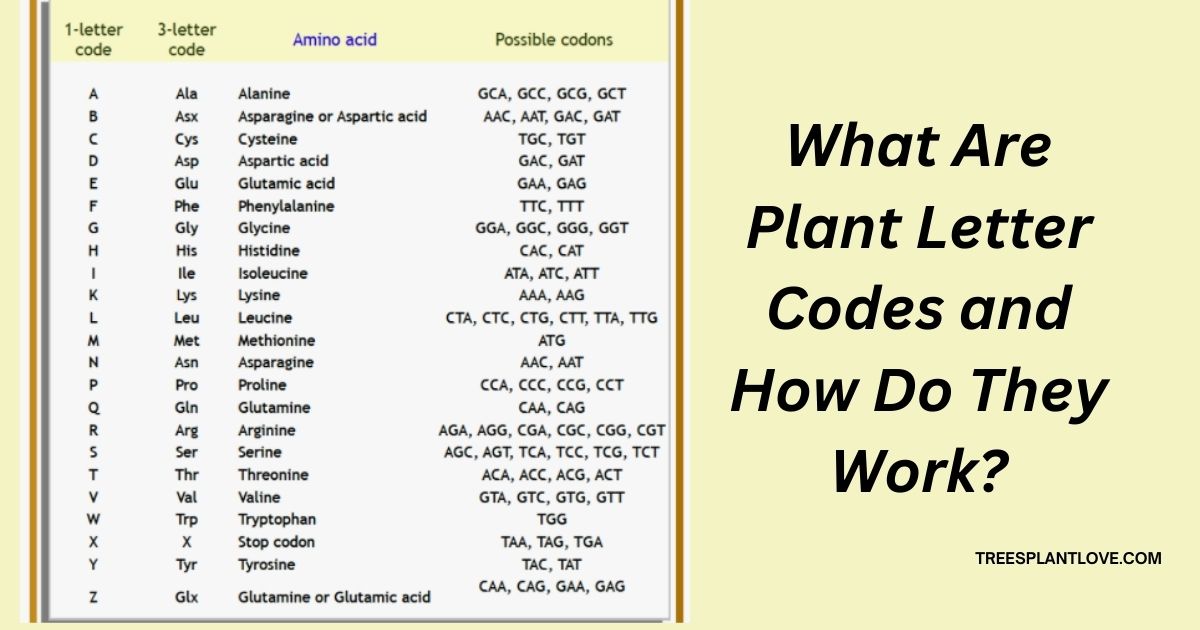
What Are Plant Letter Codes and How Do They Work? A Complete Guide for Plant Identification
What Are Plant Letter Codes and How Do They Work?: In the world of botany, horticulture, and gardening, efficiency and accuracy are paramount. Whether it’s identifying plant species, categorizing plants, or managing large collections of flora, systems that streamline this process are essential. One such system is plant letter codes.
But what exactly are these codes, and how do they function in the broader context of plant classification and care? In this article, we’ll explore what plant letter codes are, how they work, and their significance in various plant-related fields.
What Are Plant Letter Codes?
Plant letter codes are a shorthand system used to classify, identify, and catalog plant species based on specific traits or attributes.
These codes can be a combination of letters (sometimes numbers) that provide a quick reference to a plant’s characteristics or its position in a particular taxonomy system. In essence, these codes act like identifiers that allow horticulturists, gardeners, researchers, and others to access key information about a plant in an efficient and standardized way.
These codes are not arbitrary but are often derived from several factors, including:
- Genus and species names
- Plant variety or cultivar
- Plant family or order
- Cultivation codes (like breeding or hybrid information)
How Do Plant Letter Codes Work?
Plant letter codes typically work as a shorthand or reference key to indicate a plant’s characteristics or classification within a larger system. Here’s a breakdown of how they function:
- Simplifying Botanical Classification: In botany, plants are usually identified using their Latin binomial nomenclature — the genus and species name. For example, Rosa rubiginosa is the scientific name for a species of rose. However, for large collections or research, long scientific names can become cumbersome. Plant letter codes simplify this by creating a concise code that relates to the plant’s full name or classification.
- Consistent Identification: These codes provide a way to consistently identify plants across different regions, organizations, or studies. Rather than writing out the full scientific name or description, the letter code acts as a reference that can quickly direct a person to more detailed information.
- Categorizing Plants: In addition to identifying specific plants, letter codes are often used to categorize plants based on certain attributes, such as their growth habits, flowering seasons, or tolerance to environmental conditions. This system is especially helpful in botanical gardens, nurseries, and research institutions where multiple species need to be cataloged quickly.
- Encoding Information: A plant’s letter code may contain information about its taxonomy (its genus, family, and species) or more specific details, such as its color, growth rate, or size. For instance, the code “AF” might indicate a plant variety with a specific flowering pattern or growth form, while a more complex code could include seasonal behavior or resistance to diseases.
Where Are Plant Letter Codes Used?
Plant letter codes are widely used across various sectors that deal with plant cultivation, research, and preservation. Here are a few common uses of plant letter codes:
- Botanical Research: Researchers and botanists use plant letter codes to efficiently communicate plant characteristics in scientific papers, databases, and research projects. This allows for quick identification and comparison of species, cultivars, or varieties across different studies.
- Horticulture and Gardening: For gardeners and horticulturists, letter codes are often used in seed catalogs, plant nurseries, or gardening guides to quickly identify plant types. By using letter codes, they can more easily find the plants they need without sifting through long names or descriptions.
- Agricultural Use: In agriculture, plant letter codes may be used to indicate the specific variety or cultivar of a crop being grown. This helps farmers, agricultural experts, and suppliers know exactly what type of plant is being cultivated, what its needs are, and how best to care for it.
- Botanical Gardens and Arboretums: Botanical gardens and arboretums frequently use plant letter codes to organize vast collections of plants. This system allows visitors and staff alike to easily navigate large inventories of plant species, making plant identification and research much more efficient.
- Plant Breeding and Cultivation: Plant breeders and geneticists use letter codes to track hybrids, crosses, and new varieties. These codes help streamline the process of labeling and cataloging plants that are being cultivated for specific traits, such as disease resistance or improved yield.
Benefits of Using Plant Letter Codes
- Efficiency: Letter codes save time by providing a shorthand way to reference plants, reducing the need for lengthy descriptions or full scientific names. This is especially important in environments where a large number of plants need to be cataloged or accessed quickly.
- Consistency: By using standardized codes, the risk of confusion between different plants is minimized. Whether you’re working in a nursery, botanical garden, or lab, plant letter codes create a universal language that makes plant identification easier.
- Simplification: While scientific names can sometimes be hard to remember or pronounce, plant letter codes are designed to be simple and easy to remember, providing a more accessible way for both professionals and amateurs to identify plants.
- Improved Organization: Letter codes help organize plant collections in a systematic way, making it easier to find, catalog, and track different species. This is particularly useful in large-scale operations like plant breeding programs, botanical surveys, or academic research.
Common Examples of Plant Letter Codes
Plant letter codes vary based on the system being used, but here are a few common examples:
- Genus and species code: This type of code might use the first few letters of the genus and species name. For example, Salvia officinalis (sage) might be abbreviated as “SO.”
- Cultivar or variety code: This code can be used to indicate a specific cultivar or variety. For instance, a hybrid rose might have a letter code like “R-R” to represent a particular hybrid cultivar.
- Color or size codes: Some systems use letters to indicate a plant’s characteristics, such as “BL” for blue flowers or “SM” for small varieties.
- Maintenance or care codes: A code like “D” could indicate a drought-tolerant plant, while “W” could represent a plant that thrives in wet conditions.
Conclusion
Plant letter codes are a valuable tool for anyone working with plants, from professional botanists to avid gardeners. These codes help streamline plant identification, improve organization, and simplify the management of vast plant collections.
By using letter codes, people in various fields can efficiently reference and categorize plants without the confusion or length of scientific names. Whether you’re working in a botanical garden, researching new plant species, or tending to your garden, understanding and using plant letter codes can greatly enhance your plant-related endeavors.

Leave a Reply